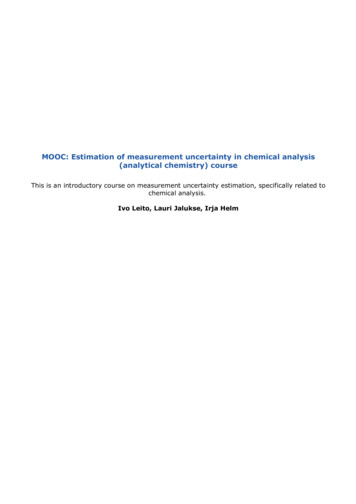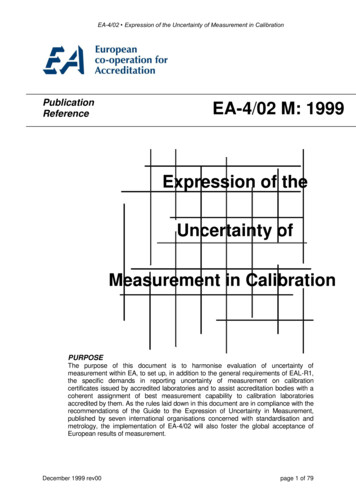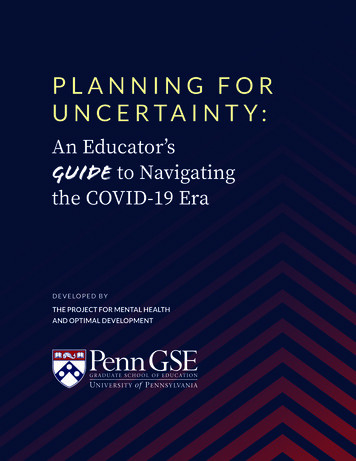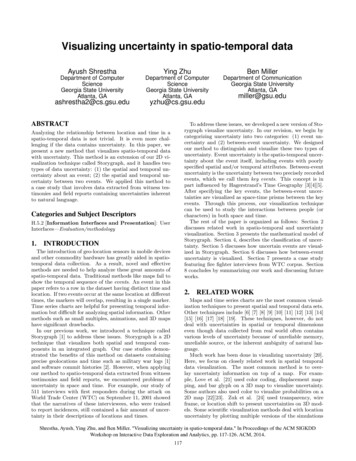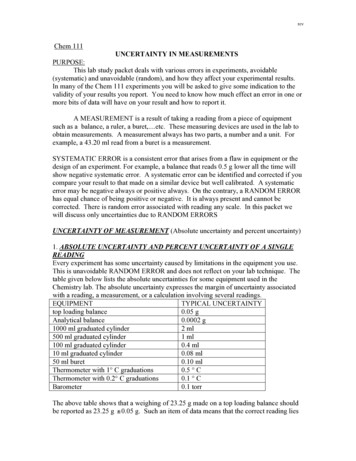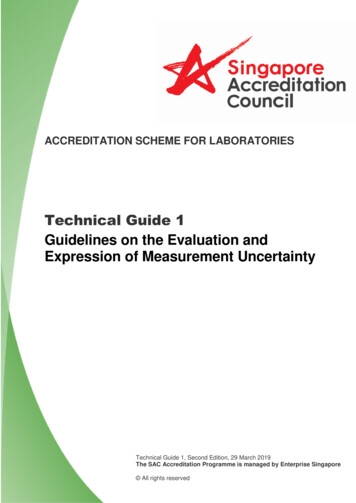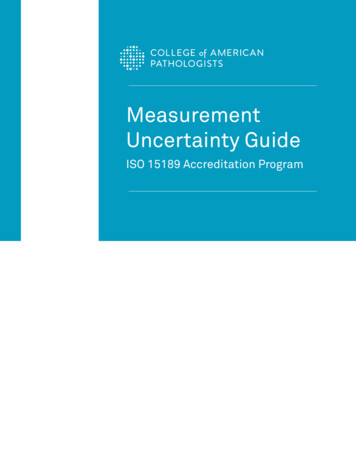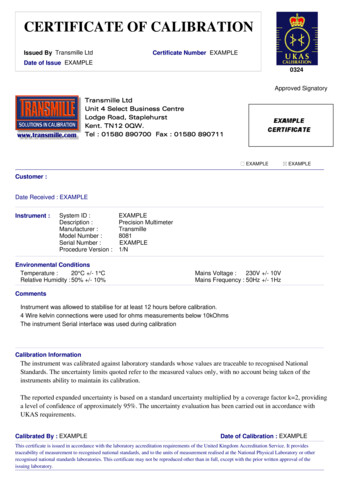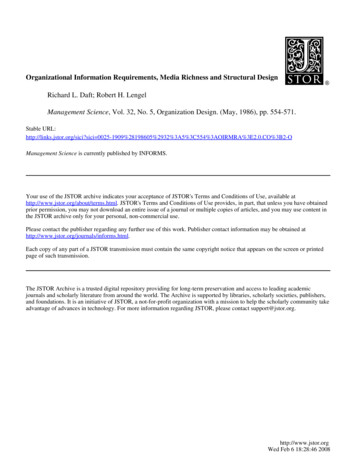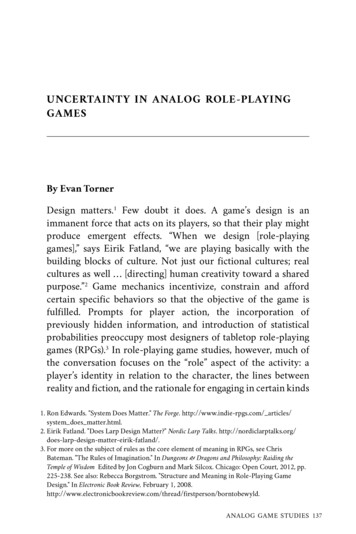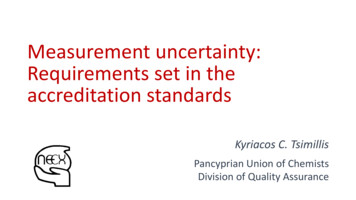
Transcription
Measurement uncertainty:Requirements set in theaccreditation standardsKyriacos C. TsimillisPancyprian Union of ChemistsDivision of Quality Assurance
Accreditation standards ISO/IEC 17025 (2005) General requirements for the competence of testingand calibration laboratories ISO/IEC DIS 17025 General requirements for the competence of testing andcalibration laboratories ISO 15189 (2012) Medical laboratories – Requirements for quality andcompetence ISO/IEC 17043 (2010) Conformity assessment – General requirements forproficiency testing ISO 17034 (2016) General requirements for the competence of referencematerial producers ISO/IEC DIS 17011 Conformity assessment – Requirements for accreditationbodies accrediting conformity assessment bodies Eurachem/CITAC Guide on R&D and non-routine analysis (under revision)Eurachem Workshop 2017MU requirements2
The Accreditation Standards are generally applicable and they do not address all specific needs ineach field; therefore additional documents are necessary to provideguidance and explanations to laboratories nts(BIPM, OIML)Eurachem Workshop 2017EA and ILACpublicationsAccreditationstandardsMU requirements3
Requirements for measurement uncertaintyusermedicallaboratoriesISO 15189Eurachem Workshop 2017testing 025AccreditationbodyISO/IEC 17011referencematerialsproducersISO 17034proficiencytestingISO/IEC17043MU requirements4
Τhe accreditation body Shall follow the requirements of EA e.g. EA 4-02 M, EA 4-16 G(or, other regional body) as well as those of ILAC i.e. P 10,P 14, G 17. Such documents comprise the basis for the EAMLA/ILAC MRA. Laboratories need to be aware of these! Further to these, the national accreditation body mayprepare additional documents, both informative of theirpolicy and guidance to the laboratories in the country.Eurachem Workshop 2017MU requirements5
Who is the user of laboratory services?testing/calibrationlaboratoryEurachem Workshop 2017 testing laboratorycalibration laboratorymanufacturercompetent authorityconsumerMU requirements6
How is uncertainty used? Is it well understood? Laboratories need to take the stated uncertainty into accountwhen evaluating the uncertainty of their results. Competent authorities need to consider the stateduncertainty to correlate the result with a legislative limit. The manufacturer can decide on adjustments needed bearingin mind contractual commitments already undertaken.(continued)Eurachem Workshop 2017MU requirements7
How is uncertainty used? Is it well understood? (2) The consumer may find it difficult to understand what this“uncertain component” of the result may mean All users need to understand the meaning of uncertaintystated on testing reports and calibration certificates and, ifnecessary, ask for clarifications.Eurachem Workshop 2017MU requirements8
A laboratory is supported by a series of different suppliers; their selection shall be basedon set criteria related to the specific supply and address theprovisions of the Standard. Are laboratories aware of accreditation standards applyingto their suppliers and the requirements included therein? Are these standards included in the list of externaldocuments and are controlled as appropriate?Eurachem Workshop 2017MU requirements9
The environment of a laboratoryNational Metrology Institute CIPM Key ComparisonsISO 17025TestingLaboratoryISO 17025CertificationBodyISO 17021Testing/CalibrationCalibrationLaboratoryISO 17025LaboratoryAccreditation BodyISO 17011 MLA/MRAReference MaterialsISO 17034Eurachem Workshop 2017Proficiency TestingSchemesISO 17043ISO 17025CustomersMU requirementsLegislation/AuthoritiesSuppliers ofEquipmentISO 9001Suppliers of ReagentsISO 900110
ISO/IEC 17025:2005 indicates that The laboratory shall have a policy and procedure(s) for theselection and purchasing of services and supplies it uses thataffect the quality of the tests and/or calibrations.What are the needs regarding measurement uncertainty(MU) Eurachem Workshop 2017MU requirements11
Accreditation standards specify that the laboratory shall evaluate the measurementuncertainty of their results; this is the case with bothISO/IEC 17025 and ISO 15189.Furthermore, ISO 17025 provides for the reporting of theresults Eurachem Workshop 2017MU requirements12
ISO/IEC 17025 specifies that for calibrationslaboratories (both calibration and testing) shall apply a procedure toestimate the uncertainty of measurement for all calibrations they carryoutfor testingsimilarly as for calibrations; in case this is not possible, laboratoriesshall at least attempt to identify all the components and make areasonable estimation In both cases all uncertainty components of importance shall betaken into accountEurachem Workshop 2017MU requirements13
When reporting a statement of the estimated uncertainty shall be included wherenecessary for the interpretation of results (ISO/IEC 17025) Testing laboratories, when- relevant to the validity or application of test results- required by the customer- it affects compliance to a specification limit; Calibration laboratories, in relation to a statement oncompliance with an identified metrological specificationEurachem Workshop 2017MU requirements14
The ISO/IEC DIS 17025 No significant change regarding MU Reference to sampling; it has been included in laboratory’sactivities Description how MU to be presented Reference to the “decision rule” (describing how MU will beaccounted for when stating conformity with a specifiedrequirement)Eurachem Workshop 2017MU requirements15
Reporting of resultsISO/IEC DIS 17025 lists common requirements for all types oflaboratory activities; when referring to a laboratory involved insampling (for subsequent testing or calibration), it indicatesthat, where necessary, relevant information regarding samplingshall be taken into account in the estimate of MU.Eurachem Workshop 2017MU requirements16
In parallel, ISO 15189 specifies that medical laboratories shall determine measurement uncertainty for each measurementprocedure define the performance characteristics for each case regularly review estimates of measurement uncertainty consider measurement uncertainty when interpreting measuredquantity values Upon request, the laboratory should make its estimates ofmeasurement uncertainty available to laboratory usersEurachem Workshop 2017MU requirements17
Three types of servicesare of particular importance, affecting the overall uncertaintybudget of the laboratory: Calibration Reference materials Proficiency testingEurachem Workshop 2017MU requirements18
Metrological traceability Are relevant criteria well defined and clear to laboratories?Example:The establishment of the metrological traceability. For part ofthe task, a testing or calibration laboratory relies on servicesprovided by a calibration Laboratory. For a long time it wasunclear which should be the requirements to be met by thecalibration services supplier Eurachem Workshop 2017MU requirements19
Is the calibration laboratory accredited? If YES,- is the property included in the accreditation scope?- is the calibration and measurement capabilities (CMC) declared fit for purpose? If NO,- how does the calibration laboratory demonstrate its metrological traceability?- is the laboratory to be served aware that it has to evaluate the situation andadequately document it? Does the national accreditation body (NAB) have clear policy to support- the said task of the laboratory- the assessment of the laboratory- the evaluation of the NAB by EA?Eurachem Workshop 2017MU requirements20
These questions were answered by .ILAC P10:2013, a policy document prepared to support theILAC MRA.It clearly indicates the need for an accredited calibrationlaboratory (although not as the only route).Recently, the DIS 17025 seems to follow the same lines. ILAC P14:2013 on the policy for uncertainty in calibrationis also important.Eurachem Workshop 2017MU requirements21
Three types of servicesare of particular importance, affecting the overall uncertaintybudget of the laboratory: Calibration Proficiency testing Reference materialsEurachem Workshop 2017MU requirements22
According to ISO/IEC 17043The PT provider shall document and provide information for aseries of issues, including the origin, metrologicαl traceabilityand measurement uncertainty of assigned values, taking intoaccount all factors including problems in homogeneity andstability.One of the purposes of interlaboratory comparisons is thevalidation of uncertainty chainsEurachem Workshop 2017MU requirements23
PT schemes in calibration shall have assigned values with metrologicaltraceability, including MU in testing metrological traceability and associated MU shallbe determined taking into account specified requirementsEurachem Workshop 2017MU requirements24
The competence of the PT providerfor the development of PT schemes refers to meeting therequirements of ISO/IEC 17043. In case the provider/scheme is accredited, competence isdocumented. If this is not the case, the laboratory shall look for othermeans to confirm the required competence.Laboratory accreditation standards do provide some support Eurachem Workshop 2017MU requirements25
What is expected from laboratories? in DIS 17025* it is noted that proficiency test providersmeeting the requirements of ISO 17043 are considered as competent (it should be considered as referring to the particularscheme) ISO 15189 notes that the (medical) laboratory shouldparticipate in schemes that substantially fulfil the requirementsof ISO/IEC 17043*ISO/IEC 17025 does not refer to any requirement on this issueEurachem Workshop 2017MU requirements26
Three types of servicesare of particular importance, affecting the overall uncertaintybudget of the laboratory: Calibration Proficiency testing Reference materialsEurachem Workshop 2017MU requirements27
Reference materials are usedin all stages of the measurement process, including Method validation Calibration Quality control They are also used in interlaboratory comparisonsEurachem Workshop 2017MU requirements28
ISO 17034 specifies that the reference material producer (RMP) shall address, amongothers, the following: establishing uncertainty budgets and estimating uncertaintiesof certified value(s) defining acceptance criteria for measurand levels and theiruncertaintiesEurachem Workshop 2017MU requirements29
Furthermore, the RMP shall provide evidence of the metrological traceability of the certified valueto a stated reference identify the uncertainty contributions to be included in theassigned uncertainty document the factors affecting the uncertainty of thecertified valueEurachem Workshop 2017MU requirements30
The competence of the RM producerrefers to meeting the requirements of ISO 17034. In case the producer is accredited, competence isdocumented. If this is not the case, the laboratory shall look for othermeans to confirm the required competence.Laboratory accreditation standards do not provide muchsupport Eurachem Workshop 2017MU requirements31
Reference materials Only ISO/IEC DIS 17025 recommends the use or referencematerials from producers that meet ISO 17034 ISO/IEC 17025 and ISO 15189 do not make any reference toISO Guide 34 which was used as the basis for thecompetence of RMP until recently when ISO 17034 waspublished.Eurachem Workshop 2017MU requirements32
A laboratory uses informationprovided by PT schemes and RMP taking into account whenestimating its uncertainty budget. Their technical competencerequired is the main selection criterion. Are they accredited? Does the particular activity fall withintheir accreditation scope, if any?Eurachem Workshop 2017MU requirements33
It is not always realisticto find accredited suppliers in every field, especially RMP;the accreditation standard ISO 17034 has been published quiterecently (replacing ISO Guide 34), thus not many RMP areaccredited as yet. In case of no accreditation status, which evidence does existfor their compliance with relevant standards?Eurachem Workshop 2017MU requirements34
In case these suppliers are not accredited The laboratory should take an additional role of consideringthe competence of the supplier Further to this and regardless of how the supplierdemonstrates competence, the laboratory should be in aposition to adequately communicate and make best use ofthe information the supplier providesEurachem Workshop 2017MU requirements35
The laboratory at the end of the route RMPlaboratoryPTcalibrationlaboratoryEurachem Workshop 2017MU requirements36
What is necessary for a laboratory either accredited or being prepared towards its accreditation?The most probable answer is “the requirements of the relevantstandard i.e. ISO/IEC 17025 (or, ISO 15189)”. Is this answer enough? Is it the only relevant to the laboratory and its activities?Eurachem Workshop 2017MU requirements37
It is expected that accreditation now covering all types of conformity assessment bodies as wellas other bodies supporting them will be more and more usedas a tool.In case all partners/players are accredited against thecorresponding standard, this would speed up theharmonisation procedure regarding conformity assessment!Eurachem Workshop 2017MU requirements38
Thank you for your attention and your questions!Eurachem Workshop 2017MU requirements39
and calibration laboratories ISO/IEC DIS 17025 General requirements for the competence of testing and calibration laboratories ISO 15189 (2012) Medical laboratories - Requirements for quality and . The laboratory shall have a policy and procedure(s) for the selection and purchasing of services and supplies it uses that
